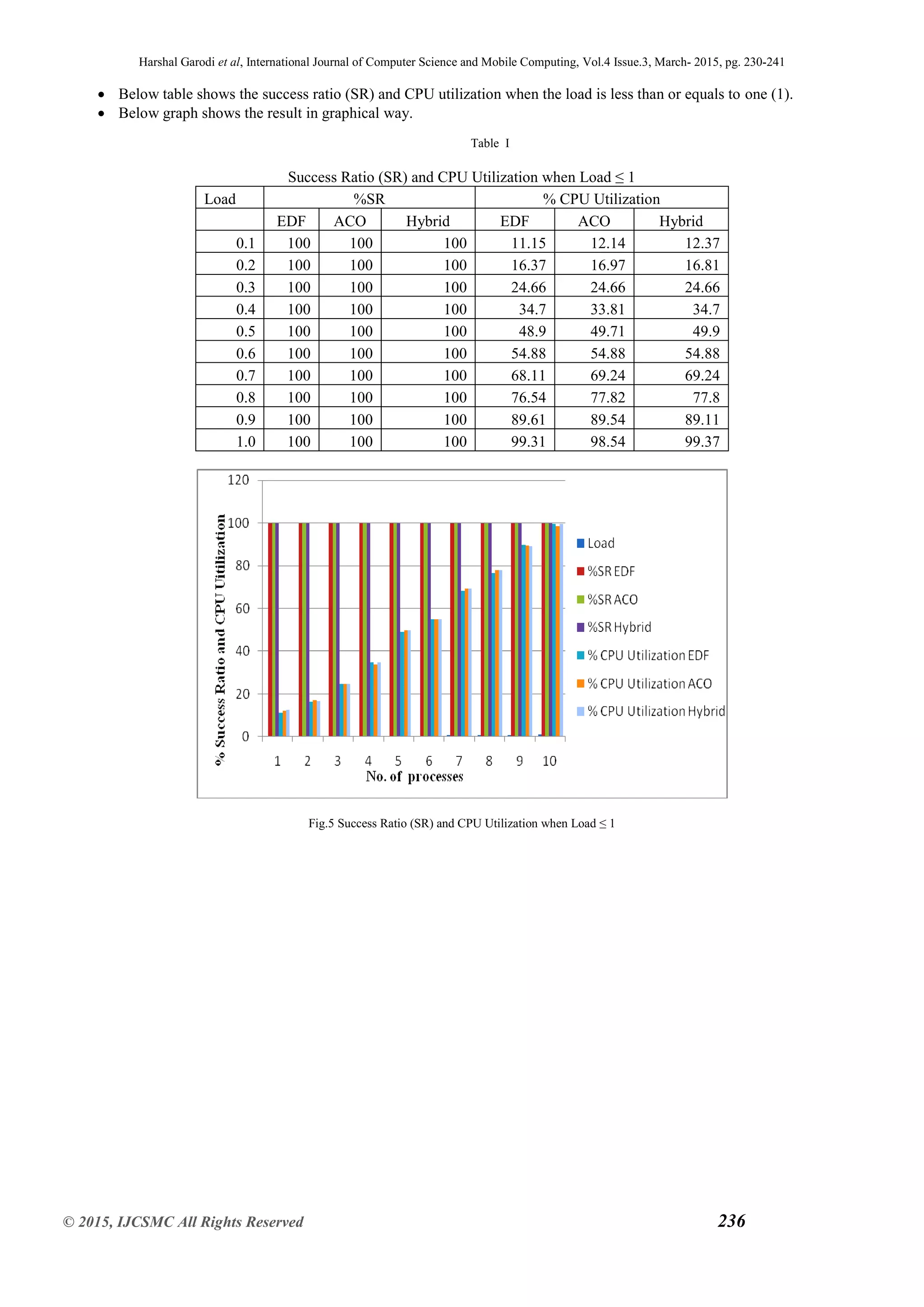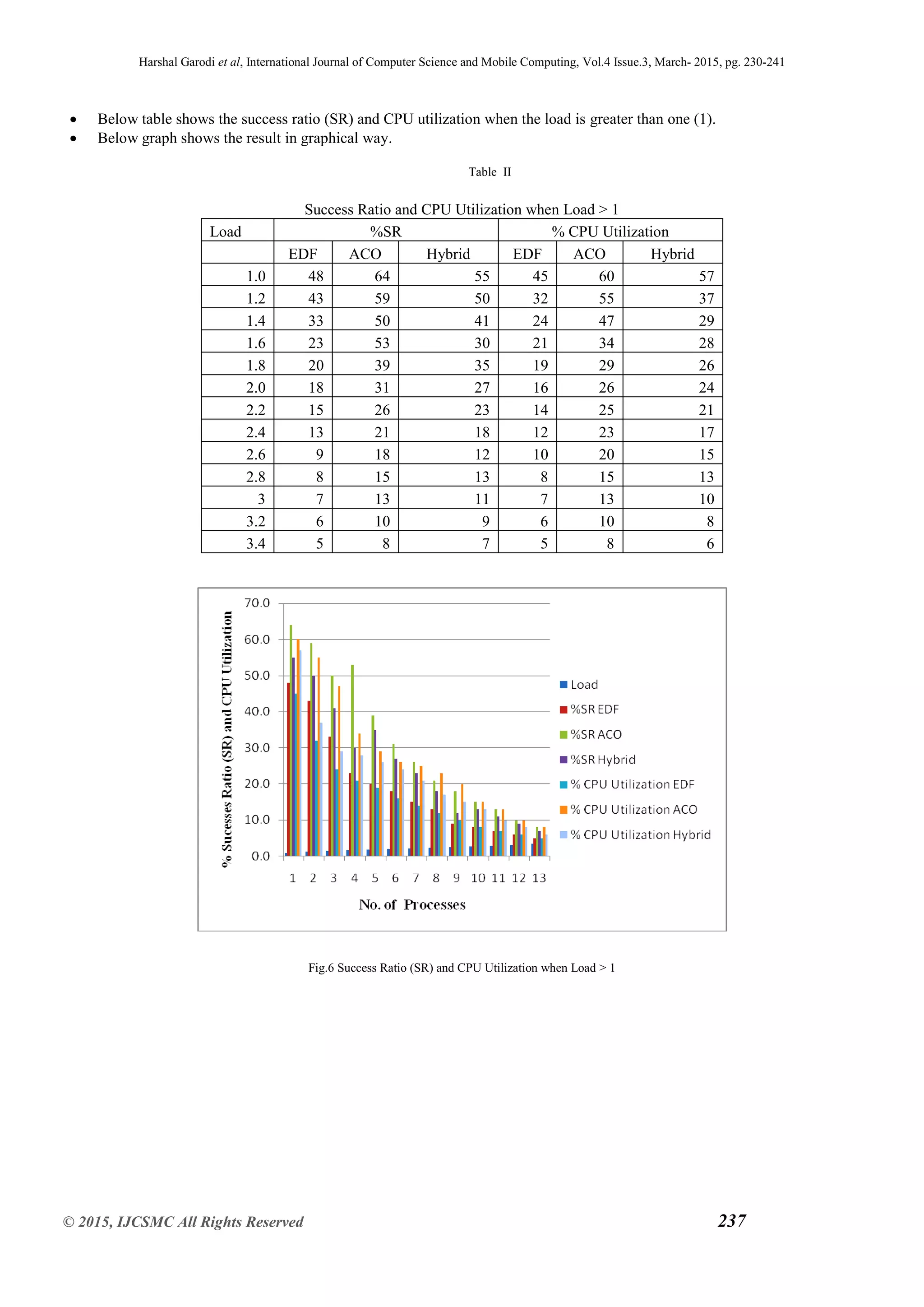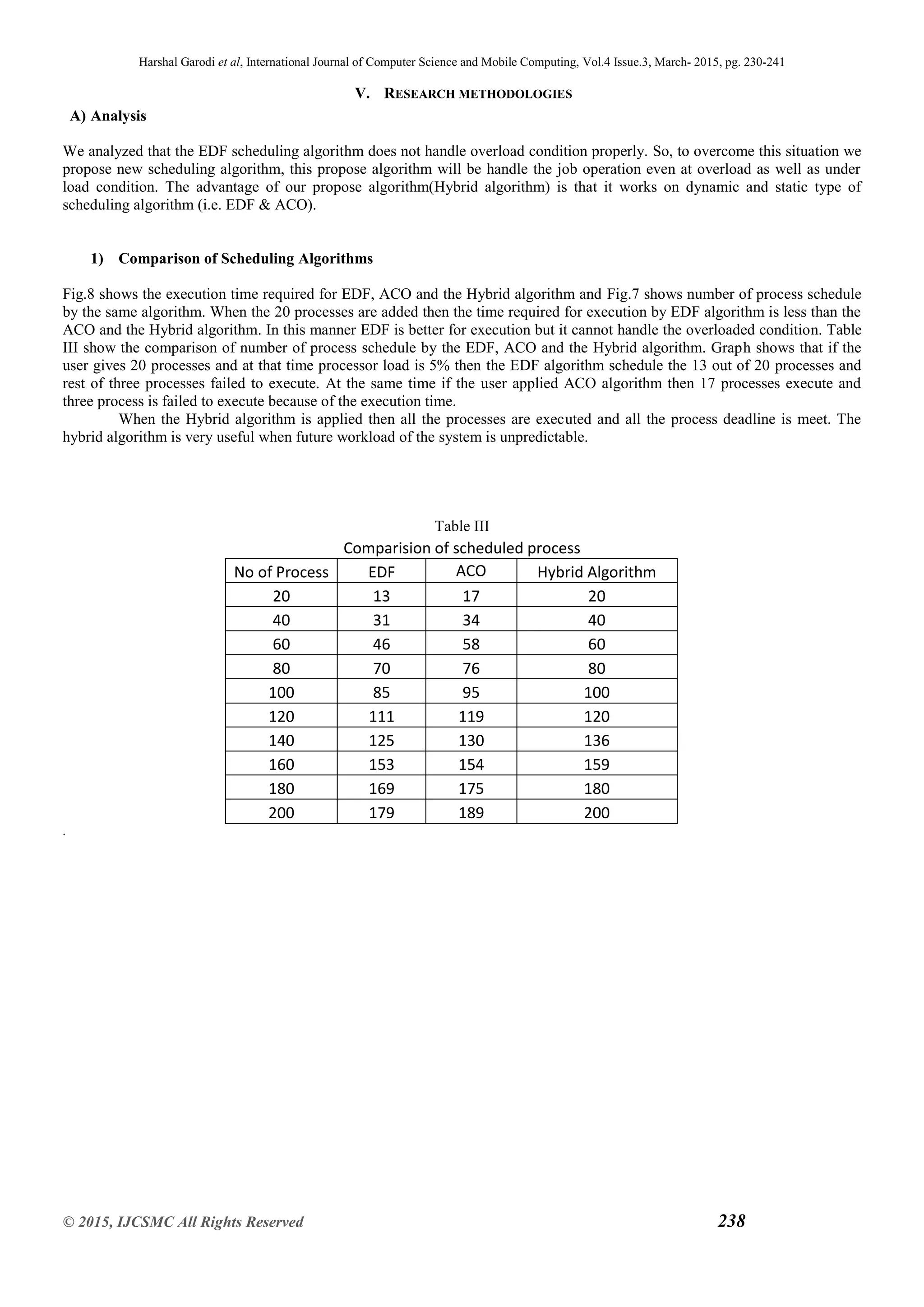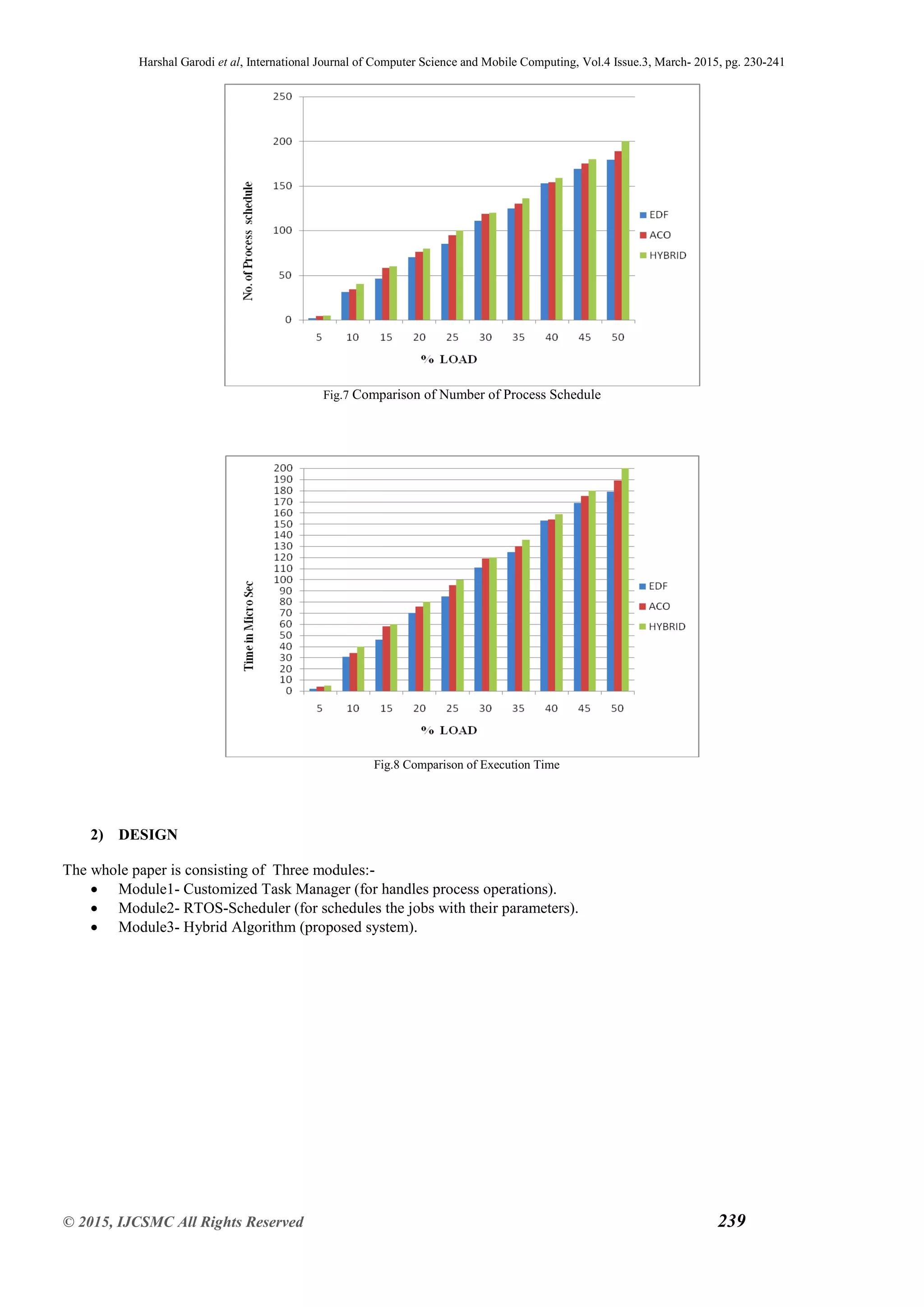This document summarizes a research article that proposes a hybrid scheduling algorithm for real-time operating systems that combines Earliest Deadline First (EDF) and Ant Colony Optimization (ACO) algorithms. The hybrid algorithm aims to overcome the limitations of EDF, which cannot handle overloaded systems well, and ACO, which has longer execution times than EDF. The document provides background on real-time operating systems and describes EDF and ACO scheduling algorithms. It then proposes the hybrid algorithm that automatically switches between EDF and ACO to leverage the advantages of both. The goal is to enhance system performance, reduce failures, and decrease missed deadlines under different load conditions.
![Harshal Garodi et al, International Journal of Computer Science and Mobile Computing, Vol.4 Issue.3, March- 2015, pg. 230-241
© 2015, IJCSMC All Rights Reserved 230
Available Online at www.ijcsmc.com
International Journal of Computer Science and Mobile Computing
A Monthly Journal of Computer Science and Information Technology
ISSN 2320–088X
IJCSMC, Vol. 4, Issue. 3, March 2015, pg.230 – 241
RESEARCH ARTICLE
Performance Enhancing in Real Time Operating
System by Using HYBRID Algorithm
Harshal Garodi#1
, Kiran More#2
, Nikhil Jagtap#3
, Suraj Chavhan#4
, Prof.Chandu Vaidya#5
1,2,3,4
Department of CSE, Rajiv Gandhi College of Engineering & Research, R.T.M.N.U, Nagpur, India
5
Lecturer, Department of CSE, Rajiv Gandhi College of Engineering & Research, R.T.M.N.U, Nagpur, India
1
harshalhrg93@gmail.com; 2
kirankmore7777@gmail.com; 3
nikhiljagtap1190@gmail.com;
4
chavhansuraj06@gmail.com; 5
chandu.nyss@gmail.com
Abstract— The Real Time Operating System (RTOS) supports applications that meet deadlines, in addition to
provides logically correct it’s outcome. In multitasking operating system for the applications request to
meeting of time deadlines and functioning in proper real time constraints, To meet the real-time constraints ;
in Real time system for scheduling the task, different scheduling algorithms used. Most of the real-time
systems are designed using priority based preemptive scheduling algorithm, worst case execution time
estimates to guarantee the execution of high priority tasks.
The hybrid Algorithm schedules the process on single processor when it is preemptive. The advantage of the
proposed algorithm is that it automatically switches between the EDF and ACO scheduling algorithm and
overcome the limitation of both the previously discussed algorithms in paper.
Keywords—Earliest Deadline First (EDF), Ant Colony Optimization (ACO), Real-Time Operating System
(RTOS), Fixed Priority (FP), Rate Monotonic (RM).
I. INTRODUCTION
Real-time systems [1][2] are playing a crucial role in our society. The applications of real-time systems being such as chemical
industries, space missions, flight control systems, military systems, and so on. All make use of real-time technologies. In other
words, real-time systems have timing requirements that must be guaranteed. The most common dynamic priority scheduling
algorithm for real-time systems is the Earliest Deadline First(EDF) which was introduced by Liu and Leyland [3] in 1973.
According to the EDF algorithm, an arrived job with the earliest deadline is executed first. The EDF algorithm has been proven
by Dertouzos [4] “Procedural Control of Physical Processes” To be optimal among all scheduling algorithms on a uniprocessor
system. In real time system sense that if a real-time task cannot be scheduled by EDF, then this task set cannot be scheduled by
any algorithm. C.L. Liu and J.W. Layland, Presented a necessary and sufficient schedulability condition for EDF systems under
the assumption that all task’s relative deadlines are equal to their periods.
The schedulability condition is that the total utilization of the task set must be less than or equal to 1 [5].](https://image.slidesharecdn.com/0a80aad7-5822-4909-8db7-eb5d7376bea1-160411091107/75/IJCSMC-Paper-1-2048.jpg)
![Harshal Garodi et al, International Journal of Computer Science and Mobile Computing, Vol.4 Issue.3, March- 2015, pg. 230-241
© 2015, IJCSMC All Rights Reserved 231
A) AIM AND OBJECTIVES:
The aim of implementing a Scheduling algorithm which is the fusion of Earliest Deadline First (EDF) and Ant Colony
Optimization (ACO) are stated below .The EDF algorithm places the process in a priority queue and run the task by using its
deadline. The priority of the processes depends upon its deadline and handles the under-loaded condition [6], [7]. The limitation
of EDF algorithm is that it cannot handle the overloaded condition.The execution of ACO algorithm is based on the execution
time.which process has less “Execution Time” is executed first. The limitation for executing process in ACO scheduling
algorithm it takes more execution time than the EDF scheduling algorithm.For that, to remove the drawbacks of EDF and ACO
we propose new algorithm that will remove the drawback of the above discussed algorithm.
Hybrid algorithm will enhance the performance of the system and reduces the system failure ratio. Also the percentage of
missing deadline is decreased. The main advantage of the Hybrid scheduling algorithm is, it will handles over-loaded and
under-loaded condition simultaneously.
B) RELATED WORK
1) Brief Information about Real-time Systems (RTOS)
Real-time systems deliver services while meets timing constraints not necessarily fast, but must meet its deadline. A real-time
system requires that results be produced within a specified deadline period .
Features of RTOS.
Clock and Timer Support
Real-Time Priority Levels
Fast Task Preemption
Requirements on Memory Management.
2) Earliest Deadline First (EDF) :-
Liu and Layland [3] described the Rate-Monotonic (RM) and the Earliest Deadline First (EDF) scheduling policies. EDF
algorithm is the type of dynamic scheduling algorithm which depends upon the deadline of the task [8].The task with the nearest
deadline gives the highest priority. EDF algorithm schedules the process and to create particular process some of the parameter
is required such as Process Start Time, Execution Time, Deadline of Process, Release Time and the Load Time of each process.
After creating the process , the process are store in a queue known as priority queue and the priority of that process depend upon
the deadline . The below Fig.1 shows the work flow of EDF algorithm.
The limitation of EDF algorithm is that it cannot handle the overloaded condition properly. In overload situations, the
performance of the system decreases and the desired output will not be achieved when scheduler schedules the process using
EDF scheduling algorithm.
The periodic task τi=(ci,pi) is characterized by two parameters i.e. execution time “ci “and period “pi”. The utilization of
periodic task “τi“ is defined as [9].
(1)
A task can be practicability scheduled using EDF algorithm if the total utilization of a task is
(2)
When the process is underloaded, the EDF algorithm executes all the process and CPU usage for that process is also minimum
but when the process is overloaded some process fails to execute. This is the drawback of EDF algorithm. To overcome this
drawback the Hybrid scheduling algorithm combines Earliest Deadline First with the Ant Colony Optimization scheduling
algorithm.](https://image.slidesharecdn.com/0a80aad7-5822-4909-8db7-eb5d7376bea1-160411091107/75/IJCSMC-Paper-2-2048.jpg)
![Harshal Garodi et al, International Journal of Computer Science and Mobile Computing, Vol.4 Issue.3, March- 2015, pg. 230-241
© 2015, IJCSMC All Rights Reserved 232
Fig. 1 EDF Scheduling Algorithm Flow Chart
3) Ant Colony Optimization (ACO) :-
ACO algorithm was proposed by Dorigo and Gambardella in the early 1990s and by now has been successfully applied to
various combinatorial optimization problems [10]. This scheduling algorithm is based on the nature of real ant, where each ant
constructs a path and one or more ants simultaneously active at the same time. ACO scheduling algorithm mainly working with
the time slice manner. The limitation of ACO algorithm is, that it takes more time for execution than the EDF algorithm.
In ACO algorithm, each ant is called as a “node” and each of them will start their journey from different node. To apply in ACO
scheduling algorithm each node is considered as a task and possibility of each node depend upon the “pheromone” value τ and
heuristic value η and it is calculated as [11].
Where,
𝑝𝑖(𝑡) is the probability of 𝑖𝑡ℎ node at time 𝑡.
𝜏𝑖 is pheromone on 𝑖𝑡ℎ node at time 𝑡.
𝜂𝑖 is a heuristic value of 𝑖th
node at time 𝑡 and is determined by,
(3)
Here,
𝑡 is current time 𝑘 is constant and 𝐷𝑖 is absolute deadline of 𝑖𝑡ℎ node.
“𝛼” and “𝛽” are constants which decide importance of 𝜏 and 𝜂 .
The ACO algorithm is applied to the process with the same parameter as the EDF algorithm. The process is switched from EDF
to ACO when the process is loaded and the process count value is more. After switching to ACO, process executed depends
upon the execution time, the process with less execution time is executed first. The advantages of ant colony optimization is it
indirectly communication between ants using pheromone variables. It also handles the overloaded condition. The behavior of
the ant is successfully applied to several optimization problems. Below Fig. 2 shows the work flow of ACO scheduling
algorithm.](https://image.slidesharecdn.com/0a80aad7-5822-4909-8db7-eb5d7376bea1-160411091107/75/IJCSMC-Paper-3-2048.jpg)
![Harshal Garodi et al, International Journal of Computer Science and Mobile Computing, Vol.4 Issue.3, March- 2015, pg. 230-241
© 2015, IJCSMC All Rights Reserved 233
Fig.2 ACO Scheduling Algorithm Flow Chart
II. LITERATURE REVIEW
Krithi Ramamritham and John Atankovic,(1994)Summarizes the state of the real-time field in the areas of scheduling and
operating system kernels and discuss paradigms underlying the scheduling approaches. In this particular paper, scheduling
paradigms were identified: like static table-driven scheduling, static priority preemptive scheduling, dynamic planning-based
scheduling and dynamic best effort scheduling. Allocation and scheduling the communication as well as processing resources in
an integrated fashion still remains a problem awaiting efficient and flexible solutions.
Jinkyu Lee and Kang G. Shin,( 2014) it defines cp-EDF in which the CP policy is applied to EDF, and analyze its
schedulability. This schedulability analysis is then utilized to develop an algorithm that assigns the optimal control parameters
of cp-EDF. The earliest-deadline-first (EDF) policy has been widely studied for the scheduling of real-time jobs for its
effectiveness and simplicity. The schedulability analysis is then utilized to develop an algorithm that assigns the optimal control
parameters of cp-EDF. Our in-depth evaluation has demonstrated that cp-EDF with the optimal parameter assignment improves
EDF schedulability over existing preemption policies by up to 7.4%.
M.Kaladevi and Dr.S.Sathiyabama,( 2010) The main objective of this paper is to compare two important task schedulers such
as Earliest Deadline First (EDF) scheduler and Ant Colony Optimization Based (ACO) scheduler. It also presents a system that
can be schedule multiple independent tasks. Tasks can obtain minimum guaranteed execution time with its performances. The
real-time constraints in Real time system for scheduling the task, different scheduling algorithms were used. Most of the real-
time systems are designed using priority based preemptive scheduling and worst case execution time estimates to guarantee the
execution of high priority tasks. The main limitations of both algorithms are; During under loaded condition, the execution time
taken by the EDF algorithm (i.e. less time) and during overloaded condition, it gives performance of ACO based scheduling
algorithm (i.e. more efficiency).
III. PROBLEM STATEMENT
The purpose of an Real Time system[1] is to fulfill it’s limitation in particular given time or its deadline.The selection of an
appropriate algorithm is necessary to fulfill RTOS task constraints. As per the literature survey made so far there are some
problems in scheduling algorithm to handle the process operations (like process crash, abnormally termination of process etc.).
In current system RM scheduling algorithm is use to handle the process operation [12].RM works on a fixed priority scheduling
algorithm and it does not support “a-periodic” task operation. Fixed priority algorithms are a sub-class of the more general class
of dynamic priority algorithms; the priority of a task does not change in these type of algorithm. In RM it does not handle
dynamic task . The most important (and analyzed) dynamic priority algorithm is EDF. The priority of a job (instancetask) is](https://image.slidesharecdn.com/0a80aad7-5822-4909-8db7-eb5d7376bea1-160411091107/75/IJCSMC-Paper-4-2048.jpg)
![Harshal Garodi et al, International Journal of Computer Science and Mobile Computing, Vol.4 Issue.3, March- 2015, pg. 230-241
© 2015, IJCSMC All Rights Reserved 234
inversely proportional to its absolute deadline. In other words, the highest priority job is the one with the earliest deadline; If
two tasks have the same absolute deadlines, then choose one of the two at random (ties can be broken arbitrary). The priority is
dynamic since it changes for different jobs of the same task.
IV. PROPOSED APPROCHES
A) PROPOSED WORK
The main aim to design “Hybrid Algorithm” is to substantially improve the performance of system and generate result
in a more accurate and timely manner (in term of RTOS constraints).
In order to overcome/reduce the overload and underload condition problem we design new scheduling algorithm i.e.
Hybrid Scheduling Algorithm; i.e. the fusion of EDF and ACO algorithm.
The limitation of the EDF algorithm is that it cannot handle the overloaded condition properly. When the overload
condition occurs in RTOS system, EDF algorithm fails to execute and that may causes the system failure.
On the other the ACO algorithm handles the overload condition properly but the execution time required for handling
process is more than the EDF scheduling algorithm.
This is the limitation of ACO; So to overcome the limitation of both the algorithm the new algorithm is developed
which is called as the “Hybrid Scheduling Algorithm”.
B) Process Handle Mechanism In EDF
The working of the EDF algorithm is as follows ; the processes are added one by one in a process queue or EDF
queue.In detail let P=(p1,p2,p3........pn)denote a set of process Pi=(ri,ei,di) is characterized by its release time “ri”,
execution time “ei” and deadline of the process “di”.
The process is added in the process queue and the process with highest priority is switched to EDF algorithm and the
switching depends upon deadline of the process .
When the process is underloaded, the EDF algorithm executes all the process and CPU usage for that process is also
minimum but when the process is overloaded some process fail to execute.
This is the main drawback of an EDF algorithm [13]. To overcome this drawback, the fusion of both the scheduling
algorithm is design;i.e. Hybrid algorithm.(refer Fig.4)
The following below Fig.3 shows the process handle mechanism of an EDF scheduling algorithm.
Fig.3 Process Working Mechanism in EDF](https://image.slidesharecdn.com/0a80aad7-5822-4909-8db7-eb5d7376bea1-160411091107/75/IJCSMC-Paper-5-2048.jpg)
![Harshal Garodi et al, International Journal of Computer Science and Mobile Computing, Vol.4 Issue.3, March- 2015, pg. 230-241
© 2015, IJCSMC All Rights Reserved 235
C) Process Handle Mechanism In ACO
In ACO algorithm, the algorithm checks the release time as well as the execution time of each process.
After that when user wants to apply the ACO algorithm for the same process which is created.
D) Proposed architecture
The below Fig.4 shows the fusion of two scheduling algorithm. The Hybrid Algorithm is the fusion of EDF and ACO
algorithm. The Hybrid Algorithm schedules the process on single processor when it is preemptive.
The advantage of the “Hybrid algorithm” is that it will automatically switches between the EDF and ACO algorithm
when the overload and underload condition occurs in the system and overcome the limitation of both the algorithms
(i.e.EDF and ACO) algorithms.
Fig.4 Proposed Architecture
E) Success Ratio(SR) and CPU Utilization
In real time system, meeting process deadline is the most important factor. For that most convenient performance metric is the
Success Ratio and it is defined as in [14].
(5)
It is same as the number of process scheduled. So the Table І shows that the Success Ratio and CPU utilization by using the
Hybrid scheduling algorithm when system is underloaded. Table ІІ shows that the Success Ratio and CPU utilization by using
the Hybrid scheduling algorithm when system is overloaded .CPU utilization is the total amount of work handle by the CPU.
CPU utilization depends upon the task or processes. Refer equation (2). When adding a new task in the system then the CPU
Utilization is high.
Depending upon the parameters process is created.Fig.3 shows the process creation mechanism. By using the above parameter
process is created one by one. Let the process 𝑃1 is created 𝑃1=(𝑑1,𝑟1,𝑒1) Where, 𝑑1 is the deadline of process 𝑃1. 𝑒1 is the
total time required for process 𝑃1. 𝑟1 is the release time of 𝑃1 . Process 𝑃1 is created and the load of process 𝑃1 is calculated as
(6)
Where,
𝑒𝑖 is the execution time required for each process.
𝑞𝑖 depends upon the value of period pi and the deadline 𝑑𝑖.](https://image.slidesharecdn.com/0a80aad7-5822-4909-8db7-eb5d7376bea1-160411091107/75/IJCSMC-Paper-6-2048.jpg)




![Harshal Garodi et al, International Journal of Computer Science and Mobile Computing, Vol.4 Issue.3, March- 2015, pg. 230-241
© 2015, IJCSMC All Rights Reserved 240
Fig.9 Flowchart of the proposed system
The above Fig.9 Shows the process creates with the parameter like start time, execution time, deadline, Number of
process are scheduled in the process queue.
During the underloaded condition, that time algorithm uses EDF scheduling algorithm and priority of that process is
decided dynamically depending according to its deadline [15].
During overloaded condition, process switches to the ACO scheduling algorithm and calculates its execution time and
minimum time required for each process then process which contain the minimum execution time is executed first.
VI. CONCLUSION
The hybrid Algorithm is a dynamic scheduling algorithm and it is beneficial for single processor real-time operating systems.
The algorithm is useful when future workload of the system is unpredictable. The hybrid Algorithm combines the EDF and
ACO algorithm. The hybrid Algorithm schedules the process on single processor when it is preemptive. The advantage of the
algorithm is that it automatically switches between the EDF and ACO algorithm and overcome the limitation of both the
algorithms (EDF and ACO) algorithms. The hybrid Algorithm requires less time for execution as compared to EDF and ACO
and the algorithm gives the result when the system is overloaded. Memory usage of the system is increased when the load of
the process is increased.
REFERENCES
Papers:
[1]Krithi ramamritham and john a. atankovic, “Scheduling Algorithms and Operating Systems Support for Real-Time Systems,”
proceedings of the IEEE, vol.82.no. 1 , january 1994.
[2]M.Kaladevi and Dr.S.Sathiyabama, “A Comparative Study of Scheduling Algorithms for Real Time Task,” International
Journal of Advances in Science and Technology, Vol. 1, No. 4, 2010.](https://image.slidesharecdn.com/0a80aad7-5822-4909-8db7-eb5d7376bea1-160411091107/75/IJCSMC-Paper-11-2048.jpg)
![Harshal Garodi et al, International Journal of Computer Science and Mobile Computing, Vol.4 Issue.3, March- 2015, pg. 230-241
© 2015, IJCSMC All Rights Reserved 241
[3]C. Liu and J. Layland, “Scheduling Algorithms for Multiprogramming in a Hard Real-Time Environment,” J. ACM, vol. 20,
pp. 46–61, 1973.
[4]M. L. Dertouzos “Control Robotics: The Procedural Control of Physical Processes,” Information Processing, 1974.
[5]Jinkyu Lee and Kang G. Shin, “Preempt a Job or Not in EDF Scheduling of Uniprocessor Systems,” IEEE Transaction on
computers , vol. 63, no. 5, May 2014.
[6]Marko Bertogna and Sanjoy Baruah , “Limited Preemption EDF Scheduling of Sporadic Task Systems,” IEEE Transactions
on Industrial Informatics, Vol. 6, no. 4, November 2010.
[7]Fengxiang Zhang and Alan Burns, “Schedulability Analysis for Real-Time Systems with EDF Scheduling,” IEEE
Transactions on Computers, Vol. 58, no. 9, September 2009.
[8]Jashweeni Nandanwar, Urmila Shrawankar, “An Adaptive Real Time Task Scheduler,” IJCSI International Journal of
Computer Science Issues, Vol. 9, Issue 6, No 1, November 2012.
[9]Xuefeng Piao, Sangchul Han, Heeheon Kim, Minkyu Park and Yookun Cho , “Predictability of Earliest Deadline Zero
Laxity Algorithm for Multiprocessor Real-Time Systems,” Proceedings of the Ninth IEEE International.
[10]Nada M. A. Al Salami, “Ant Colony Optimization Algorithm,” UbiCC Journal, Volume 4,Number 3, August 2009.
[11] W.N. Chen and J. Zhang, “An Ant Colony Optimization Approach to a Grid Workflow Scheduling Problem with Various
QoS Requirements,” IEEE Trans. System, Man, and Cybernetics- Part C, vol. 39, no. 1, pp. 29-43, Jan. 2009.
[12]Sachin R. Sakhare and Dr. M.S. Ali , “Genetic Algorithm Based Adaptive Scheduling Algorithm for Real Time Operating
Systems,” International Journal of Embedded Systems and Applications (IJESA) Vol.2, No.3, September 2012.
[13]A.F.M.Suaib Akhter, Mahmudur Rahman Khan,Shariful Islam , “Overload Avoidance Algorithm for Real-Time Distributed
System,” IJCSN International Journal of Computer Science and Network Security, Vol. 12 no.9,September 2012.
[14] Wei-Neng Chen and Jun Zhang, “Ant Colony Optimization for Software Project Scheduling and Staffing with an Event-
Based Scheduler,”IEEE Transactions on Software Engineering, Vol. 39, no. 1, January2013.
[15] Michael A. Palis, “The Granularity Metric for Fine-Grain Real-Time Scheduling,” IEEE Transactions on Computers, Vol.
54, no. 12, December 2005.
[16]Giorgio C. Buttazzo, Marko Bertogna and Gang Yao , “Limited Preemptive Scheduling for Real-Time Systems,” IEEE
Transactions On Industrial Informatics, Vol. 9, no. 1, February 2013.
Websites:
[17]www.embedded.com/electronics-blogs/beginner-s-corner/MichaelBarr/Introduction to rate monotonic scheduling,Feb-2002.
Books:
[18]Silberschatz, Galvin and Gagne , “Operating System Concepts with Java,” 8th Edition.](https://image.slidesharecdn.com/0a80aad7-5822-4909-8db7-eb5d7376bea1-160411091107/75/IJCSMC-Paper-12-2048.jpg)